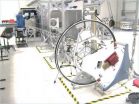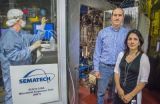(Press-News.org) We've all heard the stereotype: Women like to talk. We bounce ideas off each other about everything from career moves to dinner plans. We hash out big decisions through our conversations with one another and work through our emotions with discussion.
At least, that's what "they" say. But is any of it actually true? A new study from Northeastern University professor David Lazer's lab says it isn't that simple.
Lazer, who researches social networks and holds joint appointments in the Department of Political Science and the College of Computer and Information Sciences, took a different approach. Using so-called "sociometers" – wearable devices roughly the size of smartphones – the researchers collected real-time data about the user's social interactions. Lazer's team was able to tease out a more accurate picture of the talkative-woman stereotype we're so familiar with—and they found that context plays a large role.
But can we really make such sweeping generalizations about the communication patterns of women versus those of men? The research is surprisingly thin considering the strength of the stereotype: Some studies say yes, women are more talkative than men. Others say there's no pattern at all. Still others say men are even bigger chatterboxes.
Perhaps all this contradiction comes from the difficulty of studying such a phenomenon. Most of these studies rely on either self-reported data, in which researchers gather information by asking subjects about their past conversational exploits, or observational data, in which researchers watch the interactions directly. But both of these approaches bring with them some hefty limitations. For one thing, our memories are not nearly as good as we like to think they are. Secondly, researchers can only observe so many people at once, meaning large data sets, which offer the most statistical power to detect differences, are hard to come by. Another challenge with direct observation is that subjects may act in a more affiliative manner in front of a researcher.
The research was published Tuesday in the journal Scientific Reports and represents one of the first academic papers to use sociometers to address this kind of question. The research team includes Jukka-Pekka Onnela, who previously worked in Lazer's lab and is now at the Harvard School of Public Health, as well as researchers at the MIT Media Laboratory and the Harvard Kennedy School.
For their study, Lazer's research team provided a group of men and women with sociometers and split them in two different social settings for a total of 12 hours. In the first setting, master's degree candidates were asked to complete an individual project, about which they were free to converse with one another for the duration of a 12-hour day. In the second setting, employees at a call-center in a major U.S. banking firm wore the sociometers during 12 one-hour lunch breaks with no designated task.
"In the one setting that is more collaborative we see the women choosing to work together, and when you work together you tend to talk more," said Lazer, who is also co-director of the NULab for Texts, Maps, and Networks, Northeastern's research-based center for digital humanities and computational social science. "So it's a very particular scenario that leads to more interactions. The real story here is there's an interplay between the setting and gender which created this difference."
INFORMATION: END
Do women talk more than men? It's all about context
Use of sociometers shows that the extent that women are more talkative and collaborative than men depends on the situation
2014-07-15
ELSE PRESS RELEASES FROM THIS DATE:
NASA's Van Allen Probes show how to accelerate electrons
2014-07-15
One of the great, unanswered questions for space weather scientists is just what creates two gigantic donuts of radiation surrounding Earth, called the Van Allen radiation belts. Recent data from the Van Allen Probes -- two nearly identical spacecraft that launched in 2012 -- address this question.
The inner Van Allen radiation belt is fairly stable, but the outer one changes shape, size and composition in ways that scientists don't yet perfectly understand. Some of the particles within this belt zoom along at close to light speed, but just what accelerates these particles ...
NOAA's GOES-R satellite Magnetometer ready for spacecraft integration
2014-07-15
The Magnetometer instrument that will fly on NOAA's GOES-R satellite when it is launched in early 2016 has completed the development and testing phase and is ready to be integrated with the spacecraft.
The Magnetometer will monitor magnetic field variations around the Earth and enable forecasters at NOAA's Space Weather Prediction Center to better predict the consequences of geomagnetic storms. These storms pose a threat to orbiting spacecraft and human spaceflight. In addition, the measurements taken by the Magnetometer will aid in providing alerts and warnings to power ...
For bees and flowers, tongue size matters
2014-07-15
For bees and the flowers they pollinate, a compatible tongue length is essential to a successful relationship. Some bees and plants are very closely matched, with bee tongue sized to the flower depth. Other bee species are generalists, flitting among flower species to drink nectar and collect pollen from a diverse variety of plants. Data on tongue lengths can help ecologists understand and predict the behavior, resilience and invasiveness of bee populations.
But bee tongues are hard to measure. The scarcity of reliable lingual datasets has held back research, so Ignasi ...
Study finds why some firms are 'named and shamed' by activists
2014-07-15
COLUMBUS, Ohio – A new study of the anti-sweatshop campaigns of the 1990s reveals which companies are most likely to become targets of anti-corporate activists.
Researchers found that companies tended to attract the attention of labor activists if they were large, had prominent brand images, or had good corporate reputations. When combined, these factors were especially important.
"Companies that had all of these characteristics were nearly guaranteed to be a target of activism," said Tim Bartley, lead author of the study and associate professor of sociology at The ...
Fundamental chemistry findings could help extend Moore's Law
2014-07-15
Over the years, computer chips have gotten smaller thanks to advances in materials science and manufacturing technologies. This march of progress, the doubling of transistors on a microprocessor roughly every two years, is called Moore's Law. But there's one component of the chip-making process in need of an overhaul if Moore's law is to continue: the chemical mixture called photoresist. Similar to film used in photography, photoresist, also just called resist, is used to lay down the patterns of ever-shrinking lines and features on a chip.
Now, in a bid to continue decreasing ...
Study: Body Dysmorphic Disorder patients have higher risk of personal and appearance-based rejection sensitivity
2014-07-15
PROVIDENCE, R.I. – In a recent study, researchers at Rhode Island Hospital found that fear of being rejected because of one's appearance, as well as rejection sensitivity to general interpersonal situations, were significantly elevated in individuals with Body Dysmorphic Disorder (BDD). These fears, referred to as personal rejection sensitivity and appearance-based rejection sensitivity, can lead to diminished quality of life and poorer mental and overall health. BDD is a common, often severe, and under-recognized body image disorder that affects an estimated 1.7 to 2.4 ...
Prostate cancer in young men -- More frequent and more aggressive?
2014-07-15
ANN ARBOR, Mich. -- The number of younger men diagnosed with prostate cancer has increased nearly 6-fold in the last 20 years, and the disease is more likely to be aggressive in these younger men, according to a new analysis from researchers at the University of Michigan Comprehensive Cancer Center.
Typically, prostate cancer occurs more frequently as men age into their 70s or 80s. Many prostate cancers are slow-growing and many older men diagnosed with early stage prostate cancer will end up dying from causes other than prostate cancer.
But, the researchers found, ...
Rollout strategy for diagnostic test in India may impact TB
2014-07-15
Xpert MTB/RIF, a recently implemented tuberculosis (TB) test, has the potential to control the TB epidemic in India, but only if the current, narrow, implementation strategy is replaced by a more ambitious one that is better funded, also includes the private sector, and better referral networks are developed between public and private sectors, according to new research published in this week's PLOS Medicine. The study by David Dowdy, from Johns Hopkins University, United States, and colleagues is a mathematical model that suggests alternative strategies that include engagement ...
Molecular 'eat now' signal makes cells devour dying neighbors
2014-07-15
A team of researchers has devised a Pac-Man-style power pellet that gets normally mild-mannered cells to gobble up their undesirable neighbors. The development may point the way to therapies that enlist patients' own cells to better fend off infection and even cancer, the researchers say.
A description of the work will be published July 15 in the journal Science Signaling.
"Our goal is to build artificial cells programmed to eat up dangerous junk in the body, which could be anything from bacteria to the amyloid-beta plaques that cause Alzheimer's to the body's own ...
Neurons, brain cancer cells require the same little-known protein for long-term survival
2014-07-15
CHAPEL HILL, N.C. – Researchers at the UNC School of Medicine have discovered that the protein PARC/CUL9 helps neurons and brain cancer cells override the biochemical mechanisms that lead to cell death in most other cells. In neurons, long-term survival allows for proper brain function as we age. In brain cancer cells, though, long-term survival contributes to tumor growth and the spread of the disease.
These results, published in the journal Science Signaling, not only identify a previously unknown mechanism used by neurons for their much-needed survival, but show that ...
LAST 30 PRESS RELEASES:
Exposure to “forever chemicals” linked to higher risk of gestational diabetes, major review finds
Insilico Medicine integrates Nach01 Foundation Model with Microsoft Discovery to enable AI-native, enterprise-ready drug discovery workflows
New study reveals precursors for forecasting summer clustered extreme precipitation events in Northeast China
A bacterial toxin can counteract colorectal cancer growth
Frozen hydrogen cyanide ‘cobwebs’ offer clues to origin of life
Physics of foam strangely resembles AI training
Bis-pseudoindoxyls: a new class of single benzene-based fluorophores for bioimaging applications
Blocking a cancer-related pathway helps reduce spine deformities due to genetic disorder, finds new study
New study explores therapeutic potential of CRISPRCas3 genome-editing system
Korea University researchers revive an abandoned depression drug target using structurally novel NK1 receptor inhibitors
Jeonbuk National University researchers highlight advancements in chemical looping fluidized bed reactors
Tyrannosaurus rex grew up slowly: New study reveals the “king of dinosaurs” kept growing until age 40
Commercial water dispenser machines may contain more contamination than tap water
Death and doctors: New WSU study looks at medical student education on end-of-life care
The best hydrogen for heavy-duty transport is locally produced and green
Pregnancy-related high blood pressure varied among Asian, Pacific Islander subgroups
Measuring movement creates new way to map indoor air pollution
Europe’s crop droughts to get worse even as rain increases
New study identifies signature in blood to better predict type 2 diabetes risk
Research spotlight: developing “smart” nanoparticles to deliver targeted gene therapy in osteoarthritis
A CRISPR fingerprint of pathogenic C. auris fungi
Time warp: How marketers express time can affect what consumers buy
CBD treatment reverses key effects of fetal alcohol spectrum disorder in a mouse model
Blood sugar spikes linked to higher risk of Alzheimer's disease
Staying single for longer affects young people’s well-being
New method allows scientists to 3D-print structures within cells
Screening tool helps identify brain-related comorbidities in individuals with Duchenne muscular dystrophy
How do the active ingredients of monkfruit affect health?
News language and social networks: how do they affect the spread of immigration attitudes?
Researchers discover trigger of tendon disease
[Press-News.org] Do women talk more than men? It's all about contextUse of sociometers shows that the extent that women are more talkative and collaborative than men depends on the situation






